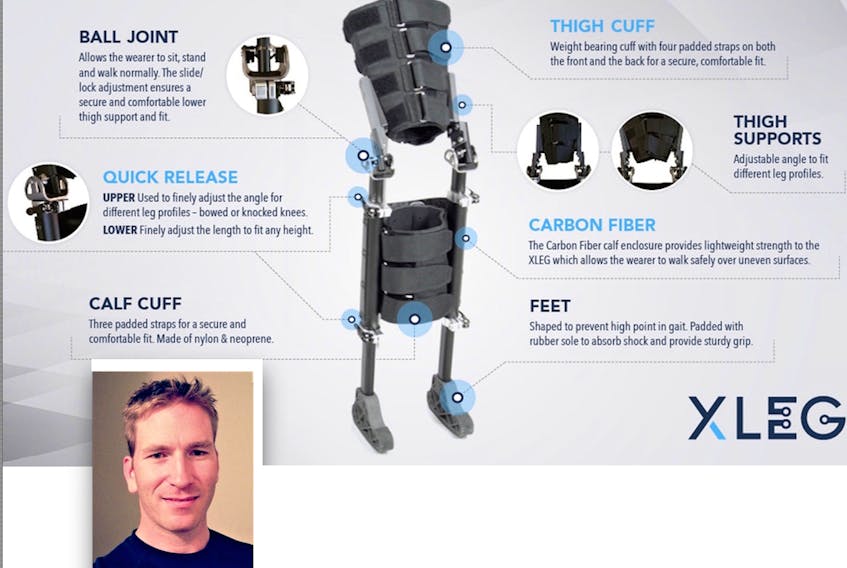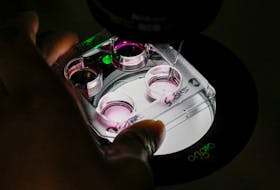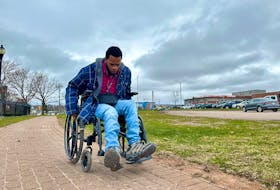CALGARY – No need to talk to Reid Robinson about ‘necessity being the mother of invention.’
He’s been there, done that.
Fifteen months and 10 surgeries after a car accident that shattered the lower portion of his right leg, the former Hilden resident embarked on a mission to design a device to serve as a hand’s-free crutch.
Numerous designs and prototypes later, he has the reached the stage of marketability for his potentially revolutionary XLEG – an adjustable, hand’s-free “mobility assistance device” that enables a user to walk normally and pain free without putting weight on the injured leg.
“I was on and off crutches quite often,” Robinson said. “I was just getting frustrated with what’s available. I had tried every crutch or crutch alternative out there and nothing really works very good.”
Robinson, 43, who lives in Calgary, was driving home on a January night in 2015 when his car suddenly lost control on a snowy, icy road.
“I was out of control, I couldn’t steer out of it,” he said. “My car went straight while the road went left and I went head on into a tree.”
The lower tibia (big bone in lower leg) and fibula (calf bone) “exploded” during the impact, Robinson said.
Over the next two and a half years Robinson underwent 13 surgeries to repair the damage and to replace the plates and other “hardware” in his leg when it didn’t hold up.
After a number of failed surgeries in 2015 and 2016, amputation was presented as an option.
“Bone grafts and skin grafts are quite painful and my surgeon related a number of stories where others had chosen amputation over additional surgeries with no guarantee of success,” he said.
Amputation would have enabled him to be up and walking with the help of a prosthetic limb within a few months, he said. But that was not the route he wanted to go.
During the period when he was researching various prosthetic limb options, however, Robinson began thinking about the possibility of implementing aspects of those designs into a hands-free crutch.
In March 2016, 15 months after the accident and while recovering from his 10th surgery,
he came up with the initial design for what has become a form of exoskeleton for the leg.
“I drew it up and said, ‘this works, someone has to make something like this,’” he said. But he couldn’t find anything on the market that did what his design proposed.
A computer engineer who describes himself as “a pretty handy guy” who can “build and fix anything,” Robinson purchased a welder and taught himself how to weld aluminum.
“And then within about three weeks I built the first version in my garage.”
Robinson and his wife have so far invested about $200,000 into his device. He has also received more than $115,000 in grants from the Alberta government along with support from about 10 medical professionals in Calgary and Edmonton who provided written endorsements for further development and patient testing.
He also took his prototype to a professional design company for further refinement.
“I wanted to create something that was universal that anyone could use,” he said. “And, here we are today with a model that is manufacturable, safe and is relatively easy to fit and to use.”
In order to take his invention to the next level, Robinson launched a Kickstarter campaign several weeks ago as a means of raising the necessary funding. As of Thursday, $17,692 had been pledged towards a $50,000 goal, with 13 days left to go.
Although he still walks with a bit of limp, Robinson no longer needs the use of his XLEG. But while he did, he said it enabled him to move about with ease during periods of his recovery when he could not otherwise put any weight on his injured leg.
“It’s not like anything on the market today,” he said. “And using my device, it takes no more effort than walking normally.”
And while Robinson stressed that his device is not designed for people who require assistance following knee surgery, he is already thinking ahead to a future version that could offer such assistance. He would also like to create a version that could measure how much weight a user is putting on their injured leg.
At the moment, however, his focus is on raising enough capital to make the first version of XLEG more widely available. It currently sells for about $600, including shipping.
“I’m ready to manufacture,” he said. “Being an inventor and designer I’m always improving upon it. But there comes a time where you have to actually generate some revenue.”
Fast facts
The XLEG serves as an exoskeleton and works through the use of a hinged brace which attaches to the thigh and lower leg with Velcro straps. Once properly adjusted, it takes weight off the foot and transfers it to the thigh, while leaving the toes free for balance.
Anyone interested in learning more about the XLEG can check out Robinson’s website at: www.nocrutches.com . To access his Kickstart campaign, log onto the Kickstarter homepage and search for XLEG.









